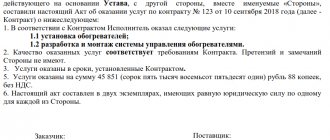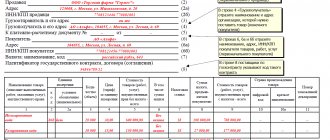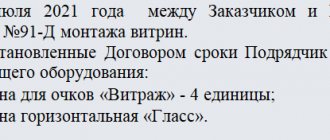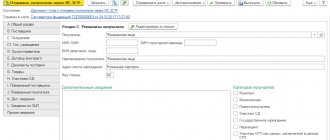Whether the UPD replaces the certificate of work performed is a question that concerns an accountant who seeks to reduce document flow. What documents are allowed to be exhibited if a company is engaged in performing work? Is it possible to combine several documents in one? We'll tell you what replaces the UPD and show you a sample of a universal transfer document.
Also see:
- What does status mean in UPD
- Is it possible to issue UPD for services?
UPD functions
In modern accounting, UPD is widely used. This abbreviation stands for – universal transfer document. However, it was introduced into circulation not so long ago - only in 2013.
The main goal of UPD is to reduce the number of documents drawn up for one transaction. This document is most relevant for companies that carry out work and, for this purpose, simultaneously sell their goods or products to the client. Let's look further at why this happens.
How does UPD reduce the number of documents? The bottom line is that its main function is to combine a primary document and an invoice. The UPD replaces the certificate of completion of work/certificate of services rendered or a delivery note issued under a transaction in combination with an invoice.
IMPORTANT!
The UPD form was proposed in the letter of the Federal Tax Service of Russia dated October 21, 2013 No. ММВ-20-3/96.
The invoice form was taken as the basis for the universal transfer document. In 2021, some changes were made to it, and in 2021 the following UPD form is relevant:
Why did we indicate that the form was proposed the Federal Tax Service? The fact is that since 2013, the unconditional use of unified forms of documents has been abolished . They began to use forms that were relatively free-form. But in any case, when drawing up such documents, only the following conditions must be observed:
- the document contains mandatory details (their list is approved by law);
- the form of the document is approved and fixed in the accounting policy of the enterprise;
- The agreement with the counterparty stipulates the use of this form of document closing the transaction.
A UPD is issued instead of a certificate of work performed (certificate of services rendered or bill of lading) and an invoice. Therefore, the mandatory details of the UPD are a compilation of the mandatory details of the primary document and invoice .
What the primary accounting document should contain (certificate of work performed/services rendered/invoice) is established by Federal Law No. 402-FZ dated December 6, 2011 on accounting. And the type of invoice is specified in Art. 169 of the Tax Code of the Russian Federation. From July 1, 2021, changes were made to the invoice form, so similar adjustments should be in the UPD.
A sample UTD with all the necessary details and data can be viewed in our article “Universal Transfer Document (UTD) from July 1, 2021: completed sample.”
Does the UPD replace the certificate of completion of work?
The universal transfer document (UDD) developed and proposed by the Federal Tax Service is a kind of symbiosis of an invoice with a primary accounting form.
According to the assumptions of tax authorities, its use should significantly reduce the document flow of the enterprise in terms of processing transactions for the supply of goods and materials, the provision of various services and other operations. This is feasible, since the document combines all the elements inherent in the forms of tax and accounting, and, therefore, can replace two documents at once, which are usually used to document any business transaction carried out by a company. Let's find out whether the UPD replaces the certificate of work performed and how this can be done in practice. Let’s say right away that the document created by the tax authorities, combining all the necessary features of the primary and settlement documents, is suitable for replacing both one act of completion of work (AWP) separately, and the act together with the corresponding invoice (SF). You just need to take into account some essential points, which we will discuss later.
The UPD form, prepared and approved by the Federal Tax Service on October 21, 2013 by letter No. ММВ-20-3/, is a recommended document, but does not oblige organizations to use it completely. Firms and businessmen can continue to draw up AVR and SF, but they can also switch to drawing up a single document designed to reduce the very cumbersome document flow that exists today.
The decision regarding the use of UPD in the company should be reflected in the corresponding order of the manager. It is also necessary to consolidate this fact in the accounting policy, since the document meets the requirements for primary documentation.
Companies are allowed to change the form of the document, adding necessary elements due to the specific features of the activity, or eliminating unnecessary lines, but the part allocated for the invoice should not be subject to changes. We must also remember about the list of details of the primary form that make it valid, i.e., lines containing such information cannot be removed from the document.
The use of UTD by the company will have to be agreed upon with its partners. Often, agreements stipulate the forms that will be drawn up as confirmation of acceptance of goods and materials/services and settlements with suppliers and customers. If the contract provides for invoices and acts, then, in order to apply a universal transfer document instead of a certificate of completion, it will be necessary to draw up an additional agreement confirming the changes.
An enterprise can issue a UPD instead of a certificate of completion in 2 cases:
In the first variation, it is enough to fill out a single transfer document, which simultaneously replaces the deed and the invoice. It is important to fill it out, guided by the recommendations dictated in the same letter from the Federal Tax Service that approved the form.
UPD used in this capacity has the status “1”, which must be entered in the existing field. Since in this case the UPD combines AVR and SF, all lines and columns required to recognize the document as both primary and settlement are filled in. In addition, a well-drafted transfer document can subsequently be used to obtain a VAT deduction.
In the second variation, a universal transfer document replaces the act of completion of work, but the SF is issued separately. The UPD used as a primary document has information status “2”, which is also indicated.
To recognize such a document as a primary document, it is necessary that all details required for primary forms are filled in, including individual lines of the part of the document reserved for the SF. There is no need to completely fill out this segment of the document, since a separate invoice will be attached to the UPD.
Note that the use of this option is more common when a company transitions to using UPD as a single document, and this period does not last long, since the effectiveness of drawing up and using one document instead of two is obvious.
Primary documents | 10:30 October 4, 2017
Primary documents | 11:36 December 15, 2014
>When does a universal transfer document replace a work completion certificate?
Application of UPD in a simplified manner
Since we are talking about using UPD instead of an invoice, a logical question arises: can a simplifier use UPD instead of a certificate of completion of work?
Yes maybe . Despite the fact that the simplifier does not issue invoices.
When applying the UPD for completed work, the simplifier must carefully consider filling out this document, namely, the “Status” field (those using the simplified tax system should use only status “2”).
Find out about indicating statuses in the UPD from our article “What does status mean in the UPD.”
UPD instead of a certificate of completion of work
According to the clarifications issued along with the form of this document in the appendices to the letter from the Federal Tax Service, universal documents can be used in two ways:
- How to replace invoices and primary documents
- Only as a replacement for the primary
Moreover, the form is recommended, not mandatory for use. Companies and entrepreneurs decide for themselves what documents they will use to document their operations, reflecting this decision in their accounting policies.
In any case of use, the UPD serves as the primary document. Therefore, it must contain all the details necessary for such documents (their list is prescribed in Article 9 of the Accounting Law). The official form developed by the Federal Tax Service includes these details. Therefore, by issuing a universal document in the official form, you will not violate the requirements of the law.
At the same time, the letter provides an approximate list of primary documents, instead of which UPD (TORG-12, OS-1, etc.) can be used. The act of completed work is not directly mentioned. In this regard, the question arises: does the UPD replace the certificate of work performed? An unambiguous answer to this question can be found in the appendices to the letter, which, among other things, indicate that the UPD can confirm the fact of delivery of the results of completed work (see the second appendix to the mentioned letter).
However, in order to issue a universal transfer document instead of a certificate of completion of work, a number of actions may be required.
As we have already indicated above, the decision to use universal documents must be recorded in the accounting policies of the company or entrepreneur. It is also necessary to determine the form of the applied UTD.
This can be either an official form (without changes) or a modified form (if desired, changes can be made to the Federal Tax Service form; in this case, it is necessary to preserve all the required details for the primary document and invoices). So, if several persons are responsible for processing a transaction in a company, then the corresponding lines (for example, line 13 can be supplemented with line 13a, providing the signatures of all persons responsible for processing the transaction).
2422 downloads 1145 downloads
Coordination of the use of a universal document may also be required on the part of counterparties, especially if the contract directly stipulates the documents used to accept the work performed and pay for it. To avoid disagreements, it is recommended to send a notification letter to correspondents about the company’s transition to using universal documents, and, if necessary, draw up an additional agreement to the contract.
At the same time, we note that nothing prevents the use, along with universal documents, of ordinary forms of acts of completed work and invoices. Such possibilities can be provided for in the accounting policies. The Federal Tax Service also reported on the admissibility of using different forms of documents even within the framework of one agreement in a letter dated May 27, 2015.
As you can see, the UPD replaces the certificate of completion, but if the above points are not taken into account, some difficulties may arise with tax authorities or contractors. If everything is taken into account, then universal documents can be safely used. Tax authorities will be required to accept them for tax purposes, VAT and income tax.
>Coffee break: are you a skilled carpenter?>Universal transfer document instead of an invoice and delivery note
Features of using UPD
When drawing up the UPD, you should remember the following features of the use of this document:
- It is unacceptable to replace an advance invoice with a universal transfer document, since when issuing an advance invoice there are no grounds for drawing up a primary document;
IMPORTANT!
An invoice can only be a primary document and cannot be only an invoice. Here we will clarify that you can issue an invoice and UPD at the same time , where the UPD will have the status “2” and act only as a primary document.
- the use of UPD is not necessary . An organization can use UPD or a package consisting of a primary document + invoice. Moreover, you can use different sets of documents with different counterparties;
- The UPD can simultaneously include not only data about the product, but also about the work performed or services provided .
And here we come to the answer to the question asked at the beginning of the article: why is UPD so beneficial to those who perform the work.
The procedure for using UPD for companies providing services
If a company provides services, then it should not have problems filling out the UPD, as well as using it. In this case, companies determine the purpose of the document - only for the purpose of replacing an invoice, or for the purpose of replacing two specified documents.
In the economic activities of companies, situations may arise when goods are simultaneously sold and services are provided. For example, loading goods, transporting goods, delivering products, etc. In this case, such companies ask a different question: is it possible to use UTD simultaneously for the purpose of selling goods and providing services?
The answer to this question will be positive: according to Federal Tax Service letter ED 4-15/17910, the use of the document for these purposes is permissible. But certain rules must be followed:
| Timely execution of UPD | At the time of registration of the UPD, the service must be provided to the consumer |
| Signing the UPD | The UPD is signed by the person obligated to sign both the invoice and other primary documents to be executed upon transfer of goods/services |
What is good about UPD for those doing the work?
For example, an organization installs equipment for a customer. In this case, she must draw up as closing documents:
- delivery note for equipment + invoice;
- act of completion of work + invoice.
If the organization is on a simplified taxation system, the number of documents is less:
- Packing list.
- Certificate of completion.
What package of documents should I give to the customer? Invoices, acts, invoices or UPD? In our opinion, the answer is obvious: one UPD instead of four (or two) documents.
Here are examples of filling out the UTD for those using the basic taxation system (OSN) and for simplifiers.
EXAMPLE
Let Principle LLC install the equipment on the customer’s vehicles.
This is what the UPD of Principle LLC looks like if the company is on OSNO:
SAMPLE UTD FOR GENERAL MODE
Let's consider the UPD of Principle LLC, if it applies the simplified tax system:
SAMPLE UPD FOR USN
Advantages of UPD
The use of universal documents greatly simplifies document flow.
Among the main advantages of UPD are:
- reduction in paper costs;
- a single document style for all types of sales (UPD replaces service certificates, TORG-12, OS-1, M-15);
- saving time on paperwork;
- reduction of the document archive.
But sometimes you can’t do without invoices. For example, an invoice is issued upon receipt of an advance payment. In this situation, there is no need to draw up a document for accounting purposes, but it is necessary for tax accounting. Therefore, the organization will not be able to issue UPD, because a document with status 1 replaces not only an invoice, but also a transfer deed, which is not required here.
To summarize, it can be noted that universal documents are the future. And over time, they will get used to them, as well as to the new forms and rules for filling out VAT documents, which were established by Decree of the Government of the Russian Federation of December 26, 2011 No. 1137.
An article by Standardization experts will tell you how to correct errors in the UPD.
Read about the features of filling out a universal adjustment document in a detailed article.
Recently, companies quite often use a document such as a UTD (universal transfer document) in their activities. This document is not mandatory for execution, despite the fact that the Ministry of Finance and the Tax Service recommend it in order to simplify the document flow in companies. The main advantage of this document is that it allows you to simultaneously access several documents from the “primary” source. At the same time, companies quite often ask themselves whether the UPD replaces the certificate of completed work? Further in the article we will try to answer this question.
When can UPD be used?
The use of UTD is not mandatory, that is, the subject of taxation can choose whether to use it at all, or use it along with traditional forms. The clarifications described situations for which UPD can be applied:
- Shipment of goods with/without transportation;
- Transfer of results of completed work;
- Provision of services;
- Intermediary operations;
- Transfer of property rights, both exclusive and under a license agreement.
To apply the UPD, the organization must approve its use in the accounting policy, as well as draw up an order from the manager to approve the UPD form.
Free expert consultation
Olga Sergeeva
Project manager
Thank you for your request!
A 1C specialist will contact you within 15 minutes.
What is “UPD status”?
The status in the UPD is clarified, since it can be used in two “qualities”:
- Status “1” is set when the UTD is used as a primary and invoice;
- Status “2” is established when the UTD is used only as a primary, only for accounting purposes.
Thus, the status shows what function the UPD has in document flow. If, when creating a UPD, the status “2” was mistakenly set, but all the fields required for the SF are filled in, then this UPD can be used to submit for deduction.
UTD with status “2” can be used by:
- Non-payers of VAT, for example, a simplified legal entity, since issuing a UTD does not oblige the calculation and payment of VAT
- Commission agents for shipment of goods to the consignor



![My business [CPS] RU](https://belovocity.ru/wp-content/uploads/moe-delo-cps-ru-330x140.jpg)




